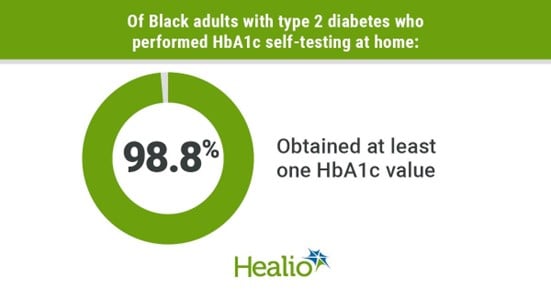HbA1c Self-testing Deemed Feasible for Black Adults with Type 2 Diabetes
HbA1c self-testing was deemed feasible in a cohort of Black adults with type 2 diabetes, though HbA1c values are slightly lower with self-testing compared with the use of a DCA laboratory device, according to study data.
In findings from the Texas Strength Through Resilience in Diabetes Education (TX STRIDE) clinical trial, participants had an overall failure rate of about 25% when trying to obtain an HbA1c value through the use of the A1CNow self-test (PTS Diagnostics) from home. After repeat testing, however, 98.8% of participants successfully completed at least one test.

Nearly all Black adults with type 2 diabetes who participated in HbA1c self-testing at home were able to obtain at least one HbA1c value. Data were derived from Woo J, et al. Sci Diabetes Self Manag Care. 2022;doi:10.1177/26350106221100536.
“Point of care devices for screening purposes and to monitor HbA1c routinely are beneficial for effective self-management and clinical care,” Mary A. Steinhardt, EdD, professor and associate vice president for research – research integrity officer in the stress adaptation and health resilience lab, department of kinesiology and health education at The University of Texas at Austin, told Healio. “Having an immediate HbA1c result available has the potential to translate to improved diabetes management and glycemic control.”
The HbA1c self-testing portion of the TX STRIDE trial occurred in two phases. During the first phase, 85 Black adults with type 2 diabetes performed at-home HbA1c self-testing during an early phase of the COVID-19 pandemic using A1CNow. Feasibility was determined by calculating the proportion of participants who successfully obtained at least one HbA1c value. In phase 2, A1CNow testing was conducted along with testing using the DCA Vantage Analyzer at church testing sites in Austin, Texas. HbA1c values on the self-test were compared with the values from the DCA Vantage Analyzer. A total of 112 adults participated in phase 2 of the study. The findings were published in The Science of Diabetes Care & Self-Management.
During phase 1, 450 self-tests were performed, including 224 at baseline, 108 at 3 months, and 118 at 6 months. Participants were unable to obtain an HbA1c value 111 times, for an overall failure rate of 24.7%. When self-testing was repeated, 98.8% of participants were able to obtain at least one HbA1c value. The results indicated a high test-retest reliability (r = 0.97; P < .001) with a within-subject coefficient of variance of 3.1%.
During phase 2, researchers performed 229 tests with A1CNow and were unable to obtain an HbA1c value 10 times, for a failure rate of 4.4%. Similar to phase 1, there was a high test-retest reliability with A1CNow (r = 0.93 ; P < .001).
Researchers analyzed 109 pairs of HbA1c values measured by both A1CNow and the DCA Vantage Analyzer in phase 2. There was a strong correlation between the two testing methods (r = 0.93; P < .001). Mean HbA1c was lower with self-testing compared with DCA testing (7.2% vs. 7.9%; P < .001).
“The performance of HbA1c point-of-care devices needs further investigation and improvements,” the researchers wrote. “Nonetheless, the widespread use of point-of-care devices for screening purposes and to monitor HbA1c routinely would be especially beneficial for vulnerable communities at high risk for developing type 2 diabetes and experiencing significant barriers to effective type 2 diabetes self-management and clinical care.”
For more information: Mary Steinhardt, EdD, can be reached at ms*********@***********as.edu.
Please review our business at: Google Yelp Facebook
If you’d like to learn more, please visit our Member’s Area to access our subscribed content.
Did you know you can work out and exercise with a trainer at your home, office, hotel room, or anywhere in the world with online personal training?
Like us on Facebook/Connect with us on LinkedIn/Follow us on Twitter
Make sure to forward this to friends and followers!
